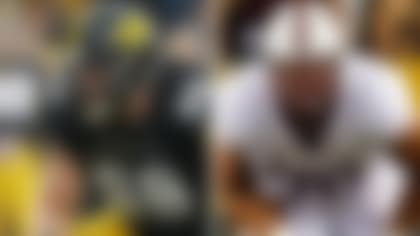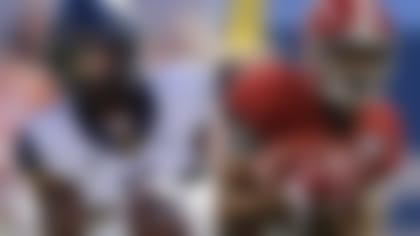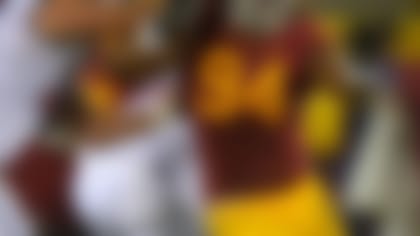The evolution of the defensive end in the NFL seems to have led us to a position that is impossible to singularly define.
There are the in-vogue hybrid defensive ends, which can line up in 4-3 fronts and play the orthodox way. Then again, they could also drop back into coverage or play off the ball as an outside linebacker, often times in a 3-4 scheme. There are the situational pass-rushing ends and the two-down, run-stopping ends. And in a 3-4 front, ends are primarily tackle-sized road blocks designed to hold blockers off heat-seeking linebackers.
Draft series: DE/DT
[ NFL.com's 10-part series looks at each position in the draft.
Draft package
» Video: Mayock's top five
»
**Photos: Top prospects**
» Chat wrap: Warren Sapp
» Archived chats
The position has been colored gray by the varying responsibilities, but for the purpose of this exercise, we're going to focus primarily on ends who play with their hands on the ground and will hardly ever be used or even considered to play any other position on the perimeter. We're also going to explore the defensive tackles, a limited group that could have significant impact at the top of the draft but provide little more than initial help in rotations after the first handful of players are selected.
This is an overall look at the defensive grunts, some of whom could emerge as stars, but at the outset of their careers will be utilized more as spokes in a wheel instead of the cog.
At defensive end, LSU's Tyson Jackson and fellow SEC product Robert Ayers, from Tennessee, are the only players projected to be chosen in the first round of the April 25-26 draft. Their hybrid peers figure to dominate at the position, but Jackson and Ayers fill roles for teams needing to firm up the defensive line with stout, three-down players who can stop the run as well as provide pressure in the pocket.
Besides providing toughness and size, being able to avoid using certain substitution packages as they relate to the defensive ends allows teams to hide schemes or plug in players at other spots without disrupting the flow of a player who is getting into a rhythm. While some players thrive as specialists, others need to remain involved in the game to retain their focus and gain advantages over offensive tackles that don't come out of games because of run or pass situations.
Jackson, who weighs nearly 300 pounds, could be effective as a 3-4 end, where his size and athleticism may be best utilized. Fewer and fewer 4-3 teams use such massive ends, especially on the pass-rushing right side, unless they move them inside to a tackle spot in passing situations.
Ayers had a great senior season and has helped himself in pre-draft workouts. He is more of a traditional 4-3 end at 272 pounds. If it weren't for the influx of hybrid types, he could be a top-20 pick. Ayers could still go that high, but also could slip into the early second round.
Draft discussion
With a top-heavy crop of DE/DTs led by B.J. Raji, is it a good idea to reach for one of the elite prospects? NFL.com's Gil Brandt and Steve Wyche debate the idea. **Read more...**
»
Draft discussions: QB |
RB |
WR |
OT
»
**Mock draft central**
Other intriguing prospects at defensive end include Utah's Paul Kruger, Georgia Tech's Michael Johnson, San Jose State's Jarron Gilbert, Texas A&M's Michael Bennett and Cincinnati's Connor Barwin, who is an ultra-hybrid as a DE/OLB and possible tight end.
The defensive tackles are regarded as one of the thinnest position groups in the draft because of the drop-off after Boston College's B.J. Raji, Mississippi's Peria Jerry and Missouri's Evander "Ziggy" Hood. While all three could go in the first round, Raji is the only projected surefire bet.
Raji is one of the most talented players in the draft and could even be a top-five selection to Seattle (No. 4) or Cleveland (No. 5). He isn't expected to fall past Denver (No. 12), which is trying to shore up one of the worst defenses in the NFL.
With Tampa Bay, Atlanta and Indianapolis in serious need of help on the defensive interior, Jerry and Hood seem like perfect fits. Both are similar in that they are relentless scrappers who can generate penetration in the running and passing games. Their versatility and size (300-plus pounds) are attractive to teams that not only have voids to fill, but are also looking to get bigger.
From there, the defensive tackle options narrow to situational players like USC's Fili Moala, who will likely operate best in situational packages. Teams tend to de-value those players somewhat and though Moala and Boston College DT Ron Brace likely will be selected in the second round, most of the remaining defensive tackles aren't expected to be chosen until Day 2 of the draft (Rounds 3-7).











